BUSM4186 - Global Entrepreneurship Research Project: Canada's Economy
VerifiedAdded on 2023/01/13
|10
|2224
|31
Report
AI Summary
This report, focused on BUSM4186 - Global Entrepreneurship, examines the factors influencing entrepreneurship in Canada. It begins with an introduction to the significance of small and medium-sized businesses in the Canadian economy, followed by an analysis of relevant demographics and economic performance data from 2013 to 2021. The report delves into Canada's global competitiveness rankings from 2017 to 2019, analyzing influential factors through a PESTLE analysis, focusing on political institutions, economic factors, social aspects, and technological innovation. It further explores factors that could support higher entrepreneurial activities, such as government funding and technology access centers. The conclusion offers recommendations for international businesses considering expansion into Canada, highlighting economic stability and cultural considerations, while also acknowledging the challenges associated with contract enforcement. The report uses data from various sources, including the World Bank, Statistics Canada, and ISED, to support its findings and recommendations.

Word
count:
1538
BUSM4186 - Global Entrepreneurship Research Project
count:
1538
BUSM4186 - Global Entrepreneurship Research Project
Paraphrase This Document
Need a fresh take? Get an instant paraphrase of this document with our AI Paraphraser
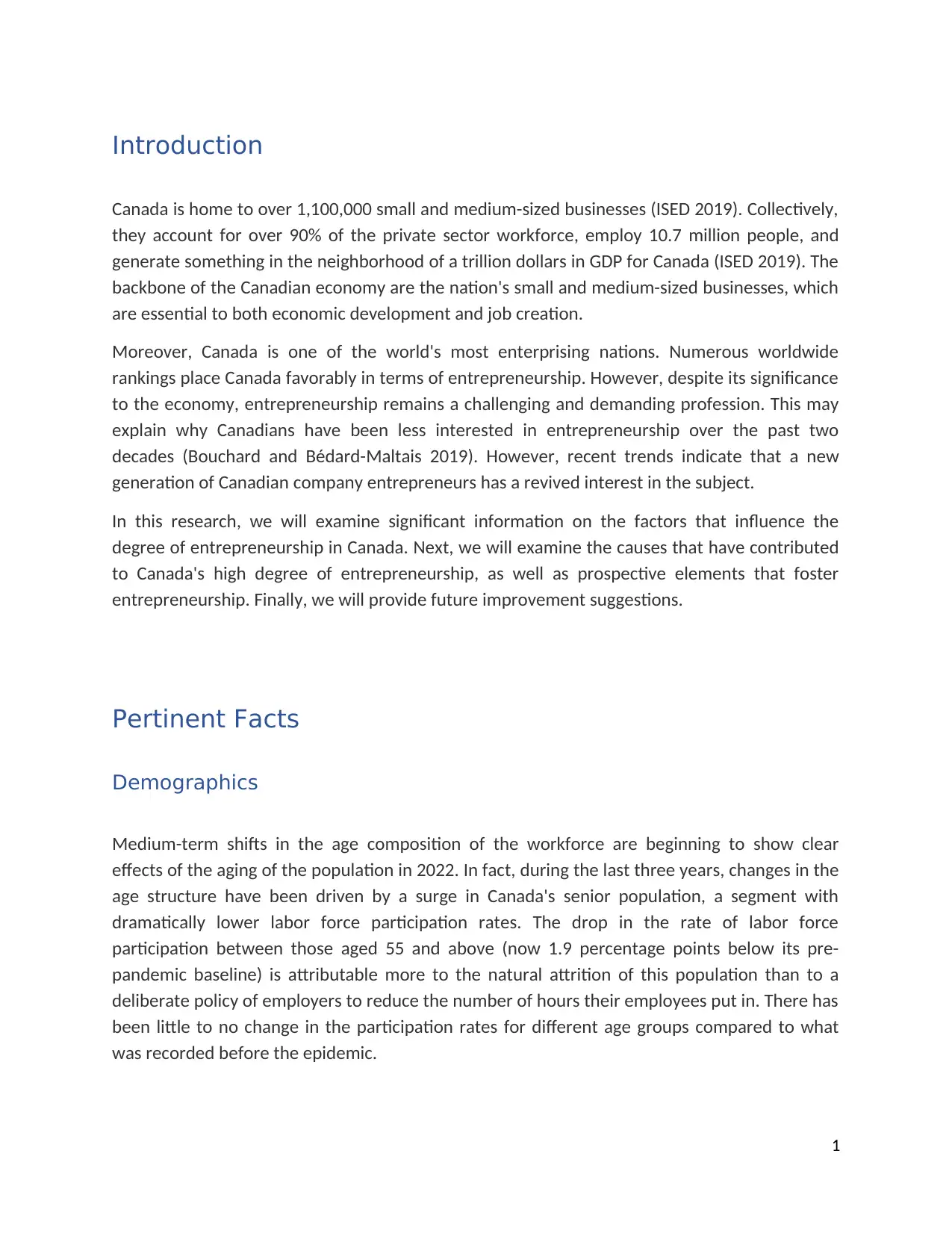
Introduction
Canada is home to over 1,100,000 small and medium-sized businesses (ISED 2019). Collectively,
they account for over 90% of the private sector workforce, employ 10.7 million people, and
generate something in the neighborhood of a trillion dollars in GDP for Canada (ISED 2019). The
backbone of the Canadian economy are the nation's small and medium-sized businesses, which
are essential to both economic development and job creation.
Moreover, Canada is one of the world's most enterprising nations. Numerous worldwide
rankings place Canada favorably in terms of entrepreneurship. However, despite its significance
to the economy, entrepreneurship remains a challenging and demanding profession. This may
explain why Canadians have been less interested in entrepreneurship over the past two
decades (Bouchard and Bédard-Maltais 2019). However, recent trends indicate that a new
generation of Canadian company entrepreneurs has a revived interest in the subject.
In this research, we will examine significant information on the factors that influence the
degree of entrepreneurship in Canada. Next, we will examine the causes that have contributed
to Canada's high degree of entrepreneurship, as well as prospective elements that foster
entrepreneurship. Finally, we will provide future improvement suggestions.
Pertinent Facts
Demographics
Medium-term shifts in the age composition of the workforce are beginning to show clear
effects of the aging of the population in 2022. In fact, during the last three years, changes in the
age structure have been driven by a surge in Canada's senior population, a segment with
dramatically lower labor force participation rates. The drop in the rate of labor force
participation between those aged 55 and above (now 1.9 percentage points below its pre-
pandemic baseline) is attributable more to the natural attrition of this population than to a
deliberate policy of employers to reduce the number of hours their employees put in. There has
been little to no change in the participation rates for different age groups compared to what
was recorded before the epidemic.
1
Canada is home to over 1,100,000 small and medium-sized businesses (ISED 2019). Collectively,
they account for over 90% of the private sector workforce, employ 10.7 million people, and
generate something in the neighborhood of a trillion dollars in GDP for Canada (ISED 2019). The
backbone of the Canadian economy are the nation's small and medium-sized businesses, which
are essential to both economic development and job creation.
Moreover, Canada is one of the world's most enterprising nations. Numerous worldwide
rankings place Canada favorably in terms of entrepreneurship. However, despite its significance
to the economy, entrepreneurship remains a challenging and demanding profession. This may
explain why Canadians have been less interested in entrepreneurship over the past two
decades (Bouchard and Bédard-Maltais 2019). However, recent trends indicate that a new
generation of Canadian company entrepreneurs has a revived interest in the subject.
In this research, we will examine significant information on the factors that influence the
degree of entrepreneurship in Canada. Next, we will examine the causes that have contributed
to Canada's high degree of entrepreneurship, as well as prospective elements that foster
entrepreneurship. Finally, we will provide future improvement suggestions.
Pertinent Facts
Demographics
Medium-term shifts in the age composition of the workforce are beginning to show clear
effects of the aging of the population in 2022. In fact, during the last three years, changes in the
age structure have been driven by a surge in Canada's senior population, a segment with
dramatically lower labor force participation rates. The drop in the rate of labor force
participation between those aged 55 and above (now 1.9 percentage points below its pre-
pandemic baseline) is attributable more to the natural attrition of this population than to a
deliberate policy of employers to reduce the number of hours their employees put in. There has
been little to no change in the participation rates for different age groups compared to what
was recorded before the epidemic.
1
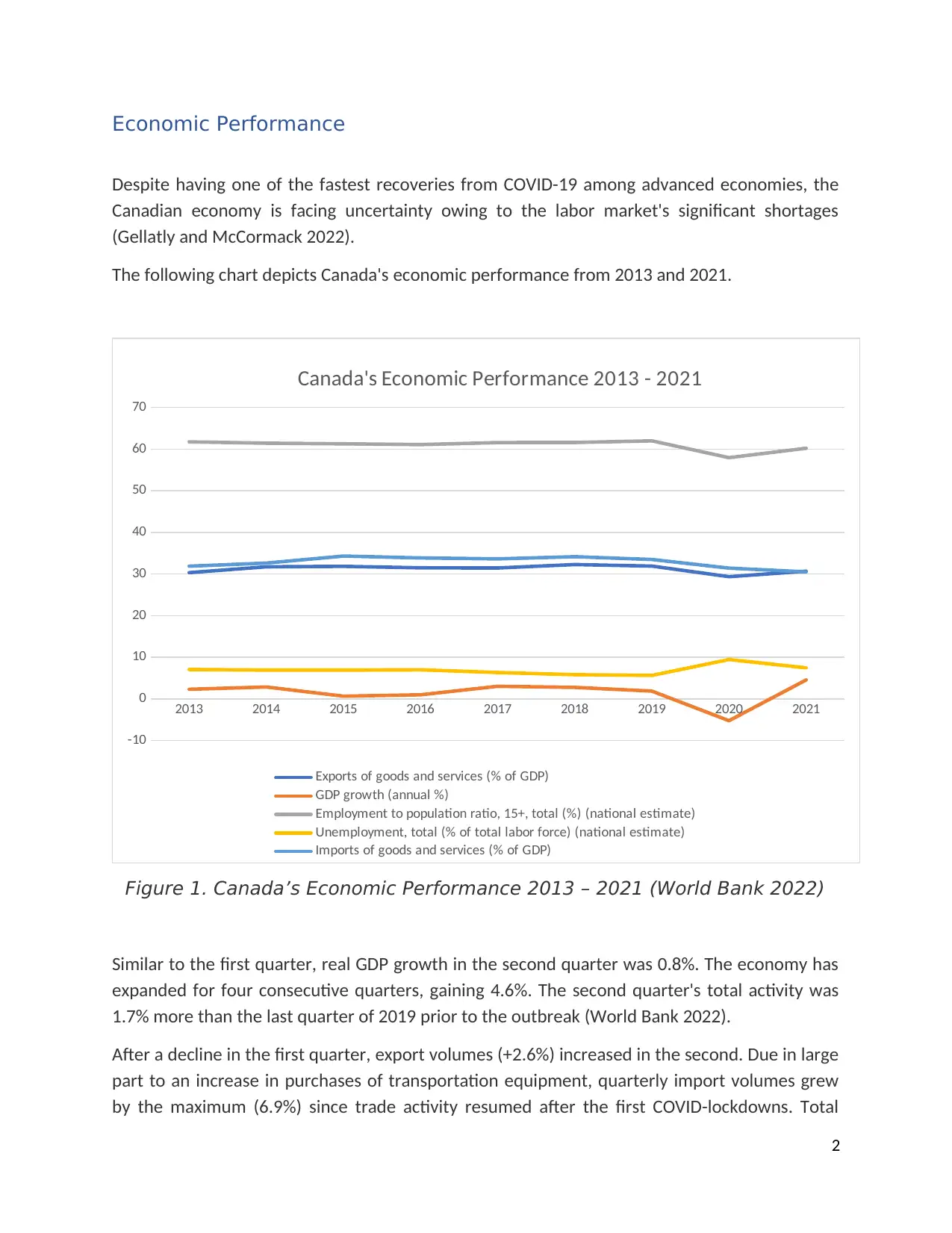
Economic Performance
Despite having one of the fastest recoveries from COVID-19 among advanced economies, the
Canadian economy is facing uncertainty owing to the labor market's significant shortages
(Gellatly and McCormack 2022).
The following chart depicts Canada's economic performance from 2013 and 2021.
2013 2014 2015 2016 2017 2018 2019 2020 2021
-10
0
10
20
30
40
50
60
70
Canada's Economic Performance 2013 - 2021
Exports of goods and services (% of GDP)
GDP growth (annual %)
Employment to population ratio, 15+, total (%) (national estimate)
Unemployment, total (% of total labor force) (national estimate)
Imports of goods and services (% of GDP)
Figure 1. Canada’s Economic Performance 2013 – 2021 (World Bank 2022)
Similar to the first quarter, real GDP growth in the second quarter was 0.8%. The economy has
expanded for four consecutive quarters, gaining 4.6%. The second quarter's total activity was
1.7% more than the last quarter of 2019 prior to the outbreak (World Bank 2022).
After a decline in the first quarter, export volumes (+2.6%) increased in the second. Due in large
part to an increase in purchases of transportation equipment, quarterly import volumes grew
by the maximum (6.9%) since trade activity resumed after the first COVID-lockdowns. Total
2
Despite having one of the fastest recoveries from COVID-19 among advanced economies, the
Canadian economy is facing uncertainty owing to the labor market's significant shortages
(Gellatly and McCormack 2022).
The following chart depicts Canada's economic performance from 2013 and 2021.
2013 2014 2015 2016 2017 2018 2019 2020 2021
-10
0
10
20
30
40
50
60
70
Canada's Economic Performance 2013 - 2021
Exports of goods and services (% of GDP)
GDP growth (annual %)
Employment to population ratio, 15+, total (%) (national estimate)
Unemployment, total (% of total labor force) (national estimate)
Imports of goods and services (% of GDP)
Figure 1. Canada’s Economic Performance 2013 – 2021 (World Bank 2022)
Similar to the first quarter, real GDP growth in the second quarter was 0.8%. The economy has
expanded for four consecutive quarters, gaining 4.6%. The second quarter's total activity was
1.7% more than the last quarter of 2019 prior to the outbreak (World Bank 2022).
After a decline in the first quarter, export volumes (+2.6%) increased in the second. Due in large
part to an increase in purchases of transportation equipment, quarterly import volumes grew
by the maximum (6.9%) since trade activity resumed after the first COVID-lockdowns. Total
2
⊘ This is a preview!⊘
Do you want full access?
Subscribe today to unlock all pages.

Trusted by 1+ million students worldwide
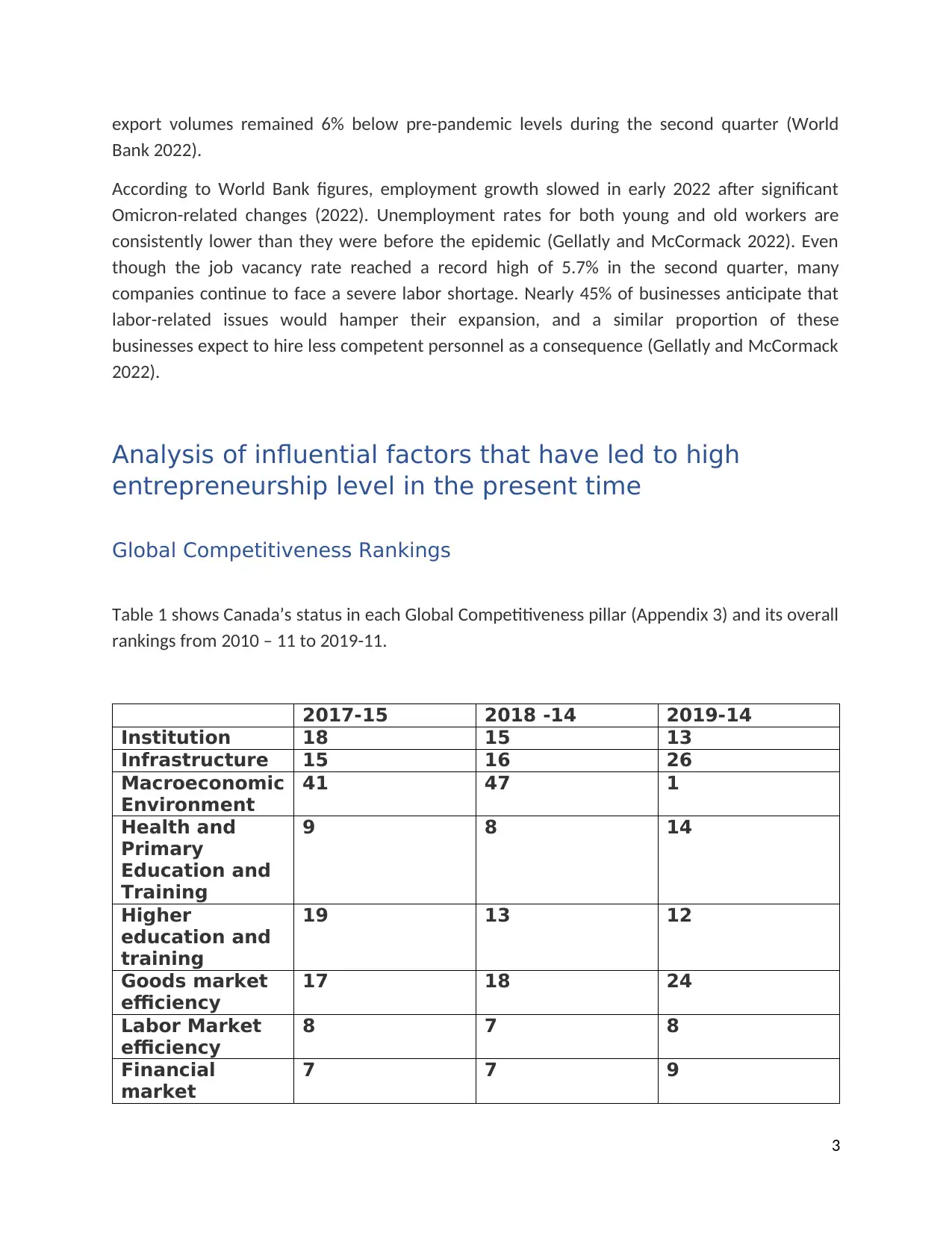
export volumes remained 6% below pre-pandemic levels during the second quarter (World
Bank 2022).
According to World Bank figures, employment growth slowed in early 2022 after significant
Omicron-related changes (2022). Unemployment rates for both young and old workers are
consistently lower than they were before the epidemic (Gellatly and McCormack 2022). Even
though the job vacancy rate reached a record high of 5.7% in the second quarter, many
companies continue to face a severe labor shortage. Nearly 45% of businesses anticipate that
labor-related issues would hamper their expansion, and a similar proportion of these
businesses expect to hire less competent personnel as a consequence (Gellatly and McCormack
2022).
Analysis of influential factors that have led to high
entrepreneurship level in the present time
Global Competitiveness Rankings
Table 1 shows Canada’s status in each Global Competitiveness pillar (Appendix 3) and its overall
rankings from 2010 – 11 to 2019-11.
2017-15 2018 -14 2019-14
Institution 18 15 13
Infrastructure 15 16 26
Macroeconomic
Environment
41 47 1
Health and
Primary
Education and
Training
9 8 14
Higher
education and
training
19 13 12
Goods market
efficiency
17 18 24
Labor Market
efficiency
8 7 8
Financial
market
7 7 9
3
Bank 2022).
According to World Bank figures, employment growth slowed in early 2022 after significant
Omicron-related changes (2022). Unemployment rates for both young and old workers are
consistently lower than they were before the epidemic (Gellatly and McCormack 2022). Even
though the job vacancy rate reached a record high of 5.7% in the second quarter, many
companies continue to face a severe labor shortage. Nearly 45% of businesses anticipate that
labor-related issues would hamper their expansion, and a similar proportion of these
businesses expect to hire less competent personnel as a consequence (Gellatly and McCormack
2022).
Analysis of influential factors that have led to high
entrepreneurship level in the present time
Global Competitiveness Rankings
Table 1 shows Canada’s status in each Global Competitiveness pillar (Appendix 3) and its overall
rankings from 2010 – 11 to 2019-11.
2017-15 2018 -14 2019-14
Institution 18 15 13
Infrastructure 15 16 26
Macroeconomic
Environment
41 47 1
Health and
Primary
Education and
Training
9 8 14
Higher
education and
training
19 13 12
Goods market
efficiency
17 18 24
Labor Market
efficiency
8 7 8
Financial
market
7 7 9
3
Paraphrase This Document
Need a fresh take? Get an instant paraphrase of this document with our AI Paraphraser
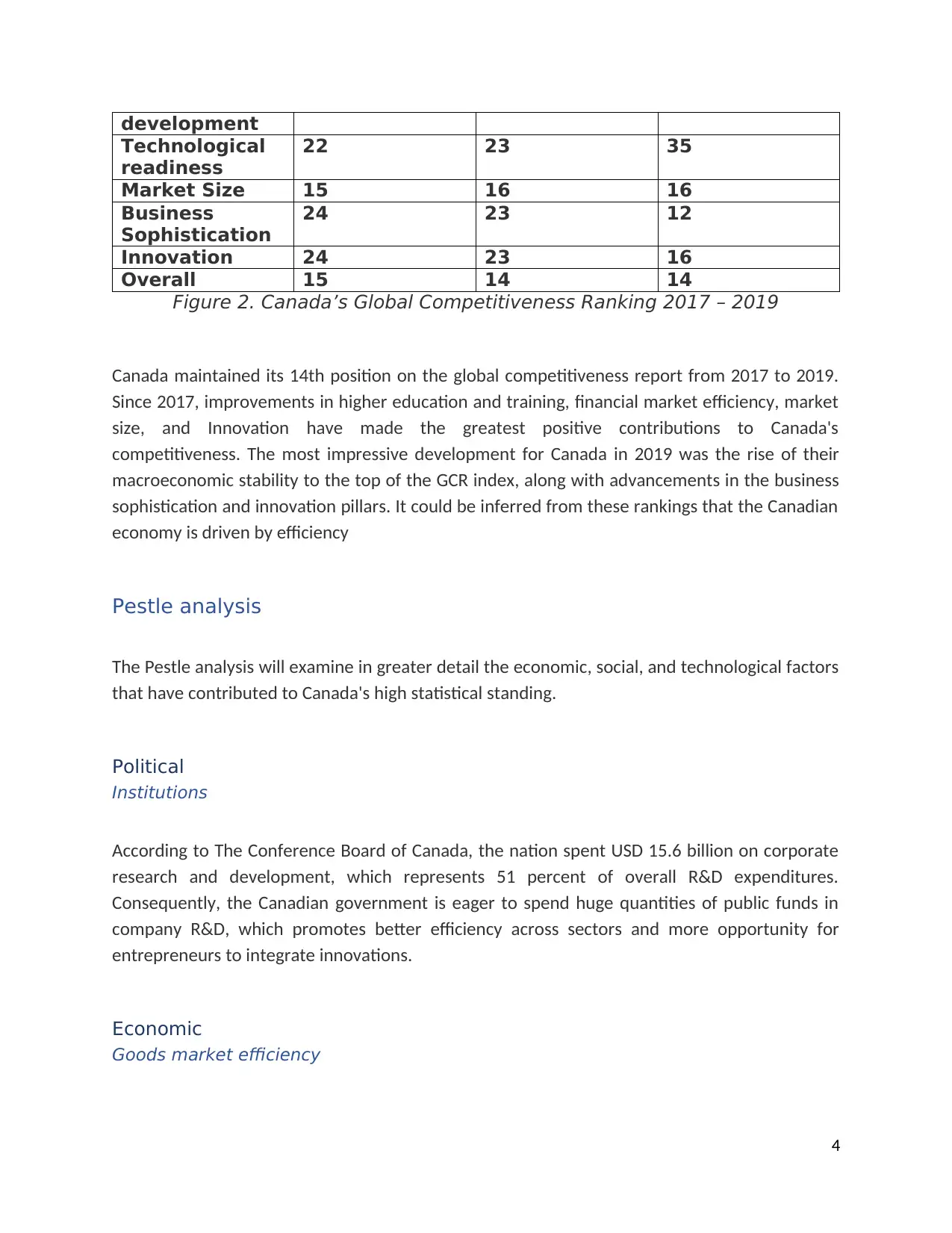
development
Technological
readiness
22 23 35
Market Size 15 16 16
Business
Sophistication
24 23 12
Innovation 24 23 16
Overall 15 14 14
Figure 2. Canada’s Global Competitiveness Ranking 2017 – 2019
Canada maintained its 14th position on the global competitiveness report from 2017 to 2019.
Since 2017, improvements in higher education and training, financial market efficiency, market
size, and Innovation have made the greatest positive contributions to Canada's
competitiveness. The most impressive development for Canada in 2019 was the rise of their
macroeconomic stability to the top of the GCR index, along with advancements in the business
sophistication and innovation pillars. It could be inferred from these rankings that the Canadian
economy is driven by efficiency
Pestle analysis
The Pestle analysis will examine in greater detail the economic, social, and technological factors
that have contributed to Canada's high statistical standing.
Political
Institutions
According to The Conference Board of Canada, the nation spent USD 15.6 billion on corporate
research and development, which represents 51 percent of overall R&D expenditures.
Consequently, the Canadian government is eager to spend huge quantities of public funds in
company R&D, which promotes better efficiency across sectors and more opportunity for
entrepreneurs to integrate innovations.
Economic
Goods market efficiency
4
Technological
readiness
22 23 35
Market Size 15 16 16
Business
Sophistication
24 23 12
Innovation 24 23 16
Overall 15 14 14
Figure 2. Canada’s Global Competitiveness Ranking 2017 – 2019
Canada maintained its 14th position on the global competitiveness report from 2017 to 2019.
Since 2017, improvements in higher education and training, financial market efficiency, market
size, and Innovation have made the greatest positive contributions to Canada's
competitiveness. The most impressive development for Canada in 2019 was the rise of their
macroeconomic stability to the top of the GCR index, along with advancements in the business
sophistication and innovation pillars. It could be inferred from these rankings that the Canadian
economy is driven by efficiency
Pestle analysis
The Pestle analysis will examine in greater detail the economic, social, and technological factors
that have contributed to Canada's high statistical standing.
Political
Institutions
According to The Conference Board of Canada, the nation spent USD 15.6 billion on corporate
research and development, which represents 51 percent of overall R&D expenditures.
Consequently, the Canadian government is eager to spend huge quantities of public funds in
company R&D, which promotes better efficiency across sectors and more opportunity for
entrepreneurs to integrate innovations.
Economic
Goods market efficiency
4
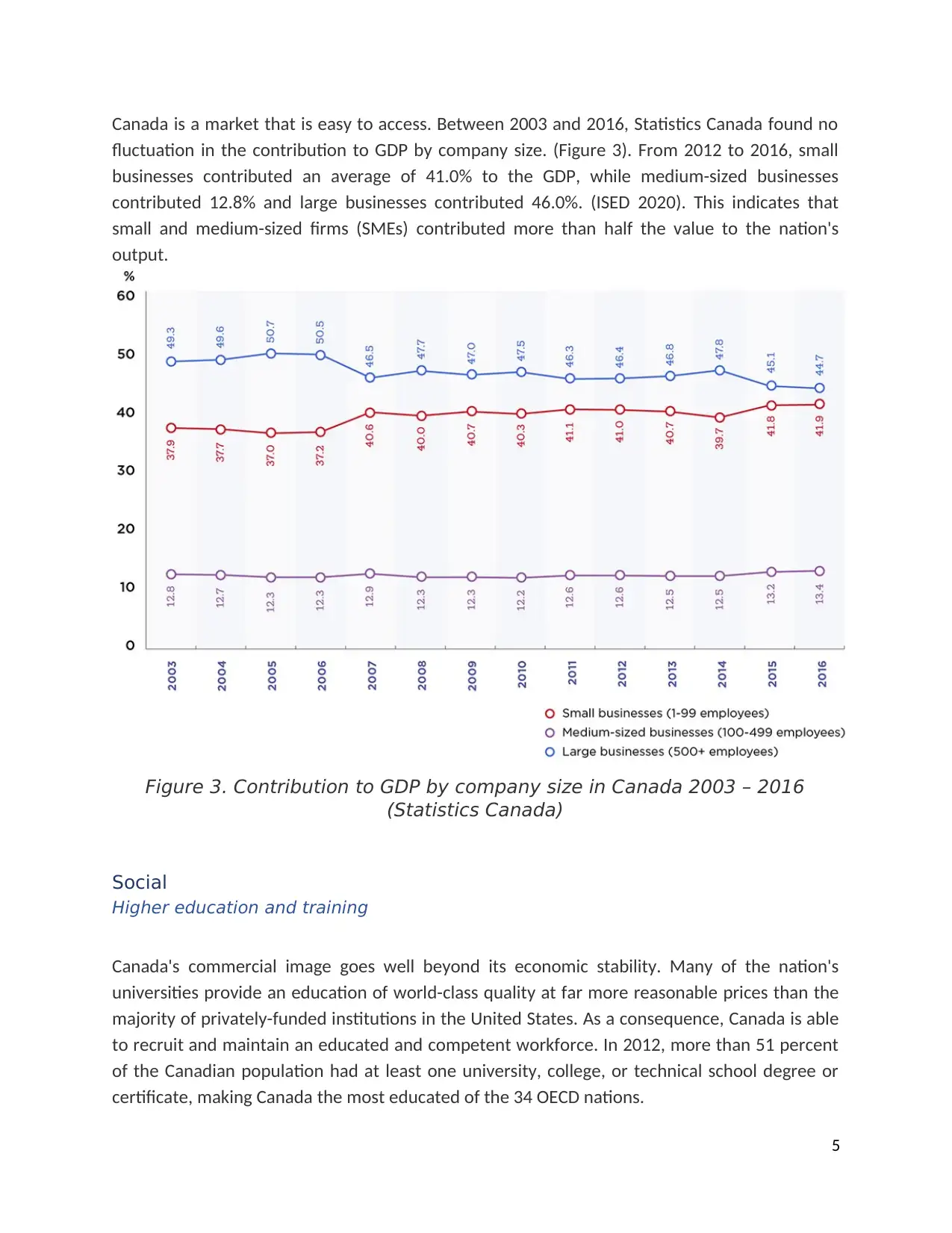
Canada is a market that is easy to access. Between 2003 and 2016, Statistics Canada found no
fluctuation in the contribution to GDP by company size. (Figure 3). From 2012 to 2016, small
businesses contributed an average of 41.0% to the GDP, while medium-sized businesses
contributed 12.8% and large businesses contributed 46.0%. (ISED 2020). This indicates that
small and medium-sized firms (SMEs) contributed more than half the value to the nation's
output.
Figure 3. Contribution to GDP by company size in Canada 2003 – 2016
(Statistics Canada)
Social
Higher education and training
Canada's commercial image goes well beyond its economic stability. Many of the nation's
universities provide an education of world-class quality at far more reasonable prices than the
majority of privately-funded institutions in the United States. As a consequence, Canada is able
to recruit and maintain an educated and competent workforce. In 2012, more than 51 percent
of the Canadian population had at least one university, college, or technical school degree or
certificate, making Canada the most educated of the 34 OECD nations.
5
fluctuation in the contribution to GDP by company size. (Figure 3). From 2012 to 2016, small
businesses contributed an average of 41.0% to the GDP, while medium-sized businesses
contributed 12.8% and large businesses contributed 46.0%. (ISED 2020). This indicates that
small and medium-sized firms (SMEs) contributed more than half the value to the nation's
output.
Figure 3. Contribution to GDP by company size in Canada 2003 – 2016
(Statistics Canada)
Social
Higher education and training
Canada's commercial image goes well beyond its economic stability. Many of the nation's
universities provide an education of world-class quality at far more reasonable prices than the
majority of privately-funded institutions in the United States. As a consequence, Canada is able
to recruit and maintain an educated and competent workforce. In 2012, more than 51 percent
of the Canadian population had at least one university, college, or technical school degree or
certificate, making Canada the most educated of the 34 OECD nations.
5
⊘ This is a preview!⊘
Do you want full access?
Subscribe today to unlock all pages.

Trusted by 1+ million students worldwide
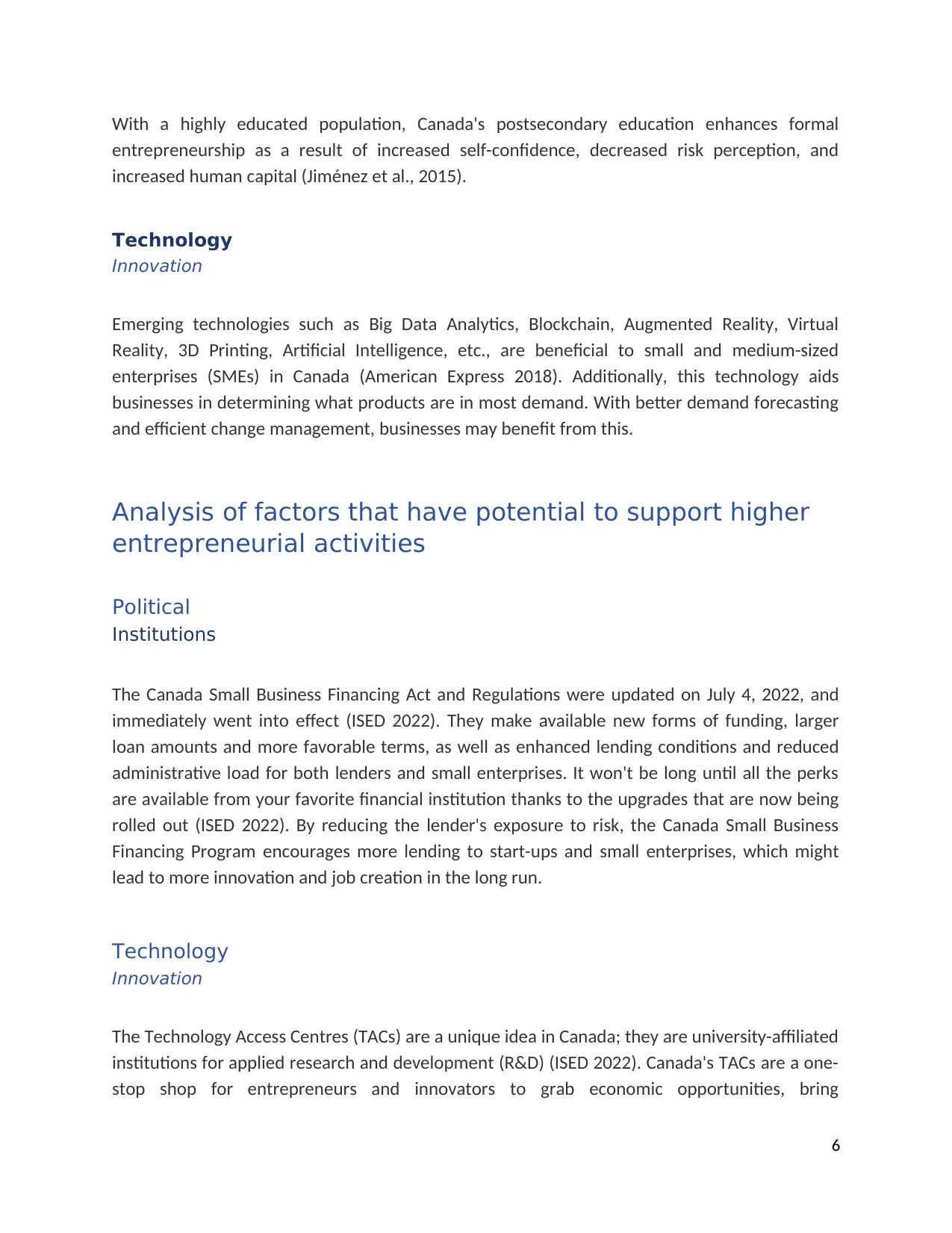
With a highly educated population, Canada's postsecondary education enhances formal
entrepreneurship as a result of increased self-confidence, decreased risk perception, and
increased human capital (Jiménez et al., 2015).
Technology
Innovation
Emerging technologies such as Big Data Analytics, Blockchain, Augmented Reality, Virtual
Reality, 3D Printing, Artificial Intelligence, etc., are beneficial to small and medium-sized
enterprises (SMEs) in Canada (American Express 2018). Additionally, this technology aids
businesses in determining what products are in most demand. With better demand forecasting
and efficient change management, businesses may benefit from this.
Analysis of factors that have potential to support higher
entrepreneurial activities
Political
Institutions
The Canada Small Business Financing Act and Regulations were updated on July 4, 2022, and
immediately went into effect (ISED 2022). They make available new forms of funding, larger
loan amounts and more favorable terms, as well as enhanced lending conditions and reduced
administrative load for both lenders and small enterprises. It won't be long until all the perks
are available from your favorite financial institution thanks to the upgrades that are now being
rolled out (ISED 2022). By reducing the lender's exposure to risk, the Canada Small Business
Financing Program encourages more lending to start-ups and small enterprises, which might
lead to more innovation and job creation in the long run.
Technology
Innovation
The Technology Access Centres (TACs) are a unique idea in Canada; they are university-affiliated
institutions for applied research and development (R&D) (ISED 2022). Canada's TACs are a one-
stop shop for entrepreneurs and innovators to grab economic opportunities, bring
6
entrepreneurship as a result of increased self-confidence, decreased risk perception, and
increased human capital (Jiménez et al., 2015).
Technology
Innovation
Emerging technologies such as Big Data Analytics, Blockchain, Augmented Reality, Virtual
Reality, 3D Printing, Artificial Intelligence, etc., are beneficial to small and medium-sized
enterprises (SMEs) in Canada (American Express 2018). Additionally, this technology aids
businesses in determining what products are in most demand. With better demand forecasting
and efficient change management, businesses may benefit from this.
Analysis of factors that have potential to support higher
entrepreneurial activities
Political
Institutions
The Canada Small Business Financing Act and Regulations were updated on July 4, 2022, and
immediately went into effect (ISED 2022). They make available new forms of funding, larger
loan amounts and more favorable terms, as well as enhanced lending conditions and reduced
administrative load for both lenders and small enterprises. It won't be long until all the perks
are available from your favorite financial institution thanks to the upgrades that are now being
rolled out (ISED 2022). By reducing the lender's exposure to risk, the Canada Small Business
Financing Program encourages more lending to start-ups and small enterprises, which might
lead to more innovation and job creation in the long run.
Technology
Innovation
The Technology Access Centres (TACs) are a unique idea in Canada; they are university-affiliated
institutions for applied research and development (R&D) (ISED 2022). Canada's TACs are a one-
stop shop for entrepreneurs and innovators to grab economic opportunities, bring
6
Paraphrase This Document
Need a fresh take? Get an instant paraphrase of this document with our AI Paraphraser
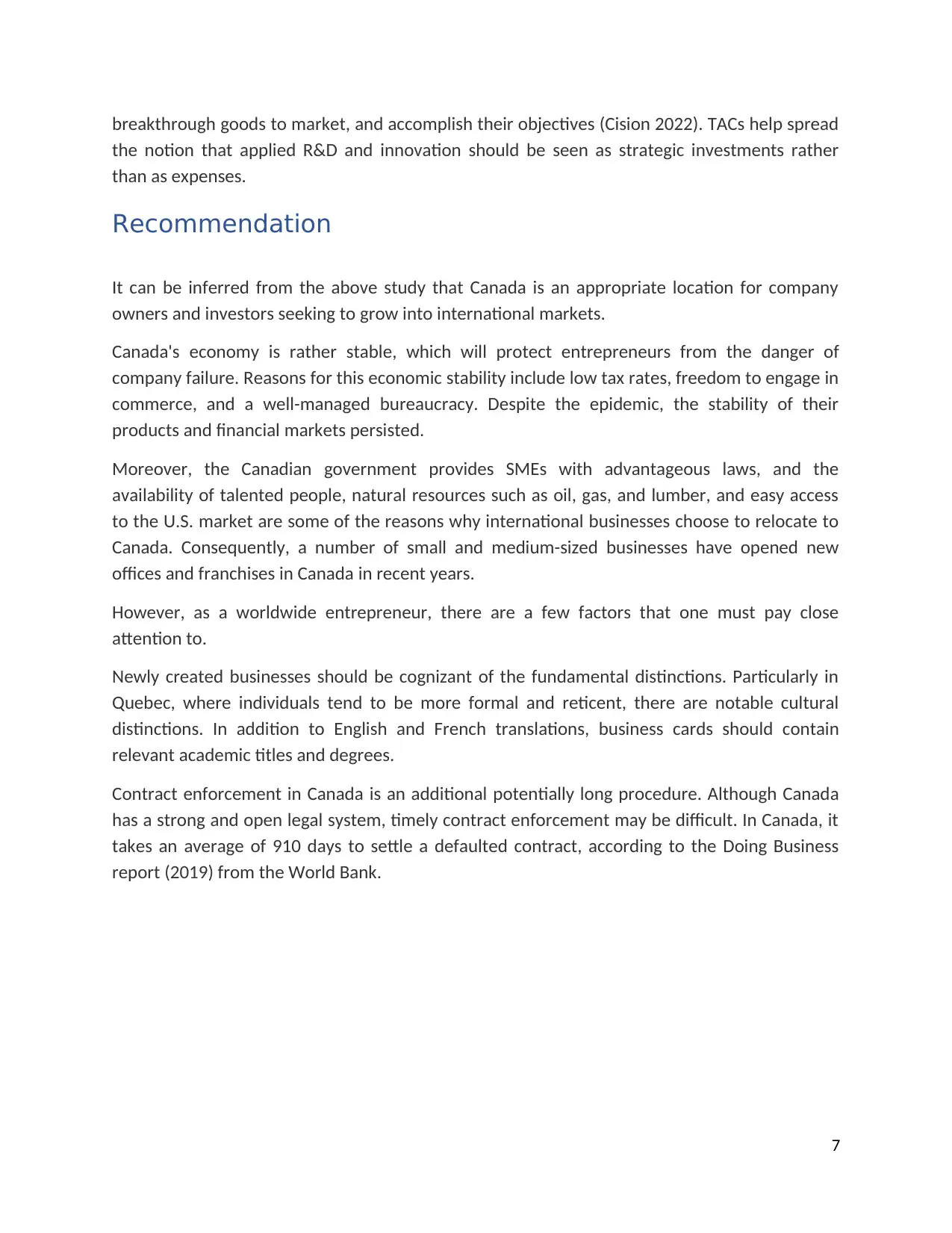
breakthrough goods to market, and accomplish their objectives (Cision 2022). TACs help spread
the notion that applied R&D and innovation should be seen as strategic investments rather
than as expenses.
Recommendation
It can be inferred from the above study that Canada is an appropriate location for company
owners and investors seeking to grow into international markets.
Canada's economy is rather stable, which will protect entrepreneurs from the danger of
company failure. Reasons for this economic stability include low tax rates, freedom to engage in
commerce, and a well-managed bureaucracy. Despite the epidemic, the stability of their
products and financial markets persisted.
Moreover, the Canadian government provides SMEs with advantageous laws, and the
availability of talented people, natural resources such as oil, gas, and lumber, and easy access
to the U.S. market are some of the reasons why international businesses choose to relocate to
Canada. Consequently, a number of small and medium-sized businesses have opened new
offices and franchises in Canada in recent years.
However, as a worldwide entrepreneur, there are a few factors that one must pay close
attention to.
Newly created businesses should be cognizant of the fundamental distinctions. Particularly in
Quebec, where individuals tend to be more formal and reticent, there are notable cultural
distinctions. In addition to English and French translations, business cards should contain
relevant academic titles and degrees.
Contract enforcement in Canada is an additional potentially long procedure. Although Canada
has a strong and open legal system, timely contract enforcement may be difficult. In Canada, it
takes an average of 910 days to settle a defaulted contract, according to the Doing Business
report (2019) from the World Bank.
7
the notion that applied R&D and innovation should be seen as strategic investments rather
than as expenses.
Recommendation
It can be inferred from the above study that Canada is an appropriate location for company
owners and investors seeking to grow into international markets.
Canada's economy is rather stable, which will protect entrepreneurs from the danger of
company failure. Reasons for this economic stability include low tax rates, freedom to engage in
commerce, and a well-managed bureaucracy. Despite the epidemic, the stability of their
products and financial markets persisted.
Moreover, the Canadian government provides SMEs with advantageous laws, and the
availability of talented people, natural resources such as oil, gas, and lumber, and easy access
to the U.S. market are some of the reasons why international businesses choose to relocate to
Canada. Consequently, a number of small and medium-sized businesses have opened new
offices and franchises in Canada in recent years.
However, as a worldwide entrepreneur, there are a few factors that one must pay close
attention to.
Newly created businesses should be cognizant of the fundamental distinctions. Particularly in
Quebec, where individuals tend to be more formal and reticent, there are notable cultural
distinctions. In addition to English and French translations, business cards should contain
relevant academic titles and degrees.
Contract enforcement in Canada is an additional potentially long procedure. Although Canada
has a strong and open legal system, timely contract enforcement may be difficult. In Canada, it
takes an average of 910 days to settle a defaulted contract, according to the Doing Business
report (2019) from the World Bank.
7
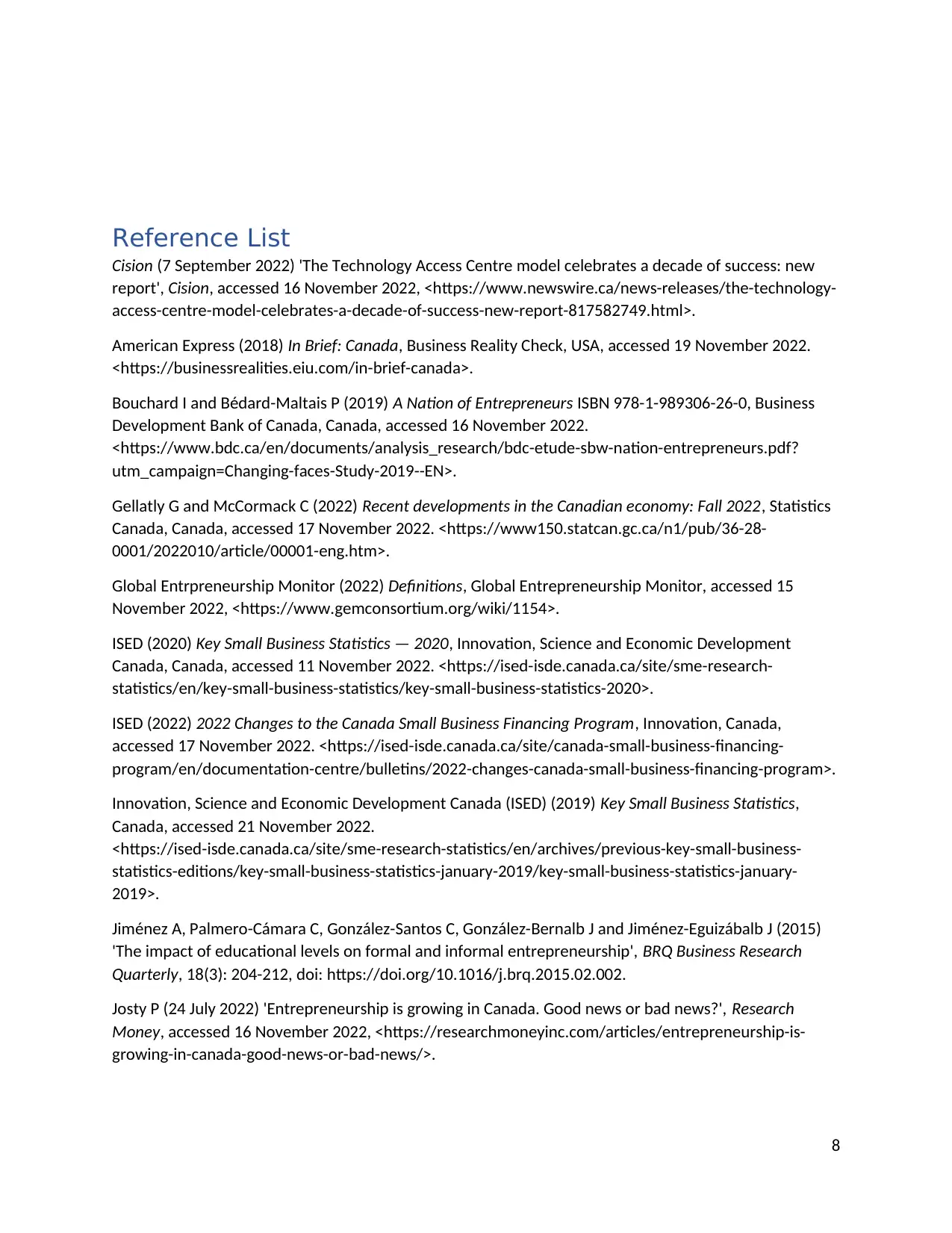
Reference List
Cision (7 September 2022) 'The Technology Access Centre model celebrates a decade of success: new
report', Cision, accessed 16 November 2022, <https://www.newswire.ca/news-releases/the-technology-
access-centre-model-celebrates-a-decade-of-success-new-report-817582749.html>.
American Express (2018) In Brief: Canada, Business Reality Check, USA, accessed 19 November 2022.
<https://businessrealities.eiu.com/in-brief-canada>.
Bouchard I and Bédard-Maltais P (2019) A Nation of Entrepreneurs ISBN 978-1-989306-26-0, Business
Development Bank of Canada, Canada, accessed 16 November 2022.
<https://www.bdc.ca/en/documents/analysis_research/bdc-etude-sbw-nation-entrepreneurs.pdf?
utm_campaign=Changing-faces-Study-2019--EN>.
Gellatly G and McCormack C (2022) Recent developments in the Canadian economy: Fall 2022, Statistics
Canada, Canada, accessed 17 November 2022. <https://www150.statcan.gc.ca/n1/pub/36-28-
0001/2022010/article/00001-eng.htm>.
Global Entrpreneurship Monitor (2022) Definitions, Global Entrepreneurship Monitor, accessed 15
November 2022, <https://www.gemconsortium.org/wiki/1154>.
ISED (2020) Key Small Business Statistics — 2020, Innovation, Science and Economic Development
Canada, Canada, accessed 11 November 2022. <https://ised-isde.canada.ca/site/sme-research-
statistics/en/key-small-business-statistics/key-small-business-statistics-2020>.
ISED (2022) 2022 Changes to the Canada Small Business Financing Program, Innovation, Canada,
accessed 17 November 2022. <https://ised-isde.canada.ca/site/canada-small-business-financing-
program/en/documentation-centre/bulletins/2022-changes-canada-small-business-financing-program>.
Innovation, Science and Economic Development Canada (ISED) (2019) Key Small Business Statistics,
Canada, accessed 21 November 2022.
<https://ised-isde.canada.ca/site/sme-research-statistics/en/archives/previous-key-small-business-
statistics-editions/key-small-business-statistics-january-2019/key-small-business-statistics-january-
2019>.
Jiménez A, Palmero-Cámara C, González-Santos C, González-Bernalb J and Jiménez-Eguizábalb J (2015)
'The impact of educational levels on formal and informal entrepreneurship', BRQ Business Research
Quarterly, 18(3): 204-212, doi: https://doi.org/10.1016/j.brq.2015.02.002.
Josty P (24 July 2022) 'Entrepreneurship is growing in Canada. Good news or bad news?', Research
Money, accessed 16 November 2022, <https://researchmoneyinc.com/articles/entrepreneurship-is-
growing-in-canada-good-news-or-bad-news/>.
8
Cision (7 September 2022) 'The Technology Access Centre model celebrates a decade of success: new
report', Cision, accessed 16 November 2022, <https://www.newswire.ca/news-releases/the-technology-
access-centre-model-celebrates-a-decade-of-success-new-report-817582749.html>.
American Express (2018) In Brief: Canada, Business Reality Check, USA, accessed 19 November 2022.
<https://businessrealities.eiu.com/in-brief-canada>.
Bouchard I and Bédard-Maltais P (2019) A Nation of Entrepreneurs ISBN 978-1-989306-26-0, Business
Development Bank of Canada, Canada, accessed 16 November 2022.
<https://www.bdc.ca/en/documents/analysis_research/bdc-etude-sbw-nation-entrepreneurs.pdf?
utm_campaign=Changing-faces-Study-2019--EN>.
Gellatly G and McCormack C (2022) Recent developments in the Canadian economy: Fall 2022, Statistics
Canada, Canada, accessed 17 November 2022. <https://www150.statcan.gc.ca/n1/pub/36-28-
0001/2022010/article/00001-eng.htm>.
Global Entrpreneurship Monitor (2022) Definitions, Global Entrepreneurship Monitor, accessed 15
November 2022, <https://www.gemconsortium.org/wiki/1154>.
ISED (2020) Key Small Business Statistics — 2020, Innovation, Science and Economic Development
Canada, Canada, accessed 11 November 2022. <https://ised-isde.canada.ca/site/sme-research-
statistics/en/key-small-business-statistics/key-small-business-statistics-2020>.
ISED (2022) 2022 Changes to the Canada Small Business Financing Program, Innovation, Canada,
accessed 17 November 2022. <https://ised-isde.canada.ca/site/canada-small-business-financing-
program/en/documentation-centre/bulletins/2022-changes-canada-small-business-financing-program>.
Innovation, Science and Economic Development Canada (ISED) (2019) Key Small Business Statistics,
Canada, accessed 21 November 2022.
<https://ised-isde.canada.ca/site/sme-research-statistics/en/archives/previous-key-small-business-
statistics-editions/key-small-business-statistics-january-2019/key-small-business-statistics-january-
2019>.
Jiménez A, Palmero-Cámara C, González-Santos C, González-Bernalb J and Jiménez-Eguizábalb J (2015)
'The impact of educational levels on formal and informal entrepreneurship', BRQ Business Research
Quarterly, 18(3): 204-212, doi: https://doi.org/10.1016/j.brq.2015.02.002.
Josty P (24 July 2022) 'Entrepreneurship is growing in Canada. Good news or bad news?', Research
Money, accessed 16 November 2022, <https://researchmoneyinc.com/articles/entrepreneurship-is-
growing-in-canada-good-news-or-bad-news/>.
8
⊘ This is a preview!⊘
Do you want full access?
Subscribe today to unlock all pages.

Trusted by 1+ million students worldwide

Statistics Canada (SC) (2020) Canada tops G7 growth despite COVID, Statistics Canada, accessed 20
November 2022, <https://www150.statcan.gc.ca/n1/daily-quotidien/220209/dq220209a-eng.htm>.
World Bank (2019) DOING BUSINESS 2019, World Bank Group, United States of America, accessed 18
November 2022. <https://www.doingbusiness.org/content/dam/doingBusiness/media/Annual-
Reports/English/DB2019-report_web-version.pdf>.
9
November 2022, <https://www150.statcan.gc.ca/n1/daily-quotidien/220209/dq220209a-eng.htm>.
World Bank (2019) DOING BUSINESS 2019, World Bank Group, United States of America, accessed 18
November 2022. <https://www.doingbusiness.org/content/dam/doingBusiness/media/Annual-
Reports/English/DB2019-report_web-version.pdf>.
9
1 out of 10
Your All-in-One AI-Powered Toolkit for Academic Success.
+13062052269
info@desklib.com
Available 24*7 on WhatsApp / Email
![[object Object]](/_next/static/media/star-bottom.7253800d.svg)
Unlock your academic potential
Copyright © 2020–2025 A2Z Services. All Rights Reserved. Developed and managed by ZUCOL.


